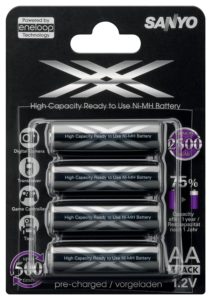Affiliate Disclosure: We earn a commission if you purchase through one of our links at no additional cost to you.
Like many photographers, I rely upon rechargeable batteries. Not just the ones that come with a product, but also on the AA size that fit in my flash and battery grip. Sadly, I learned all too much about the life and death of rechargeable batteries at the worst possible time.
As with most lessons in my life, I seem to always learn things the hard way.
The Death of an Eneloop
I primarily use two types of AA rechargeable batteries – the standard 2000 mAh Eneloop and the 2700 mAh PowerMax. Both have been very reliable. Typically, the Eneloops go in my battery grip for the Nikon D700 and D800 cameras, and I use the PowerMax in my Nikon flash for a faster recycle time.
These things have worked so well for me that I just didn’t pay attention to any warning signs that the batteries were about to die. Not slowly, with a whimper. Rather suddenly. Immediately. Right in the middle of an action shoot. You know, the time when you don’t want to think about batteries.
As always, I charged the batteries the night before. When I got to the location, I saw a full battery bar on my D700 and figured I was ready to go.
In this case, the location was in Havana at a dance rehearsal. We’re in a dilapidated old theater with a couple of dozen dancers. They’re moving, swaying, spitting fire, and doing strange things with machetes. It was engaging and fascinating.
Then my camera just died. No sound, no warning. No power. That’s never happened to me before.
In the midst of the action, I was a bit flustered. Suddenly I have to think about my gear while I’m missing some really cool shots.
It eventually occurs to me that my batteries are dead. I’m not sure why, because I just charged them last night. I had full power a few minutes ago.
A few minutes of life was all that was left in the charge capacity. These batteries that served me so well in the past had apparently given their all and fell on the field. Right when I needed them to work.
Compounding the problem was a bit of my own stupidity. I’d forgotten to bring a charger for the internal battery, and it also died.
Always Carry A Backup
Two things helped me out here. First, I had another body. The D700 was better for dance because of its faster frame rate than the D800. Second, I had another pack of batteries with me, some Immedion batteries that I got for free with an order one time. Charged up, ready to go, I put those in the battery grip and returned to shooting the dance rehearsal.
I can’t tell you how many times I’ve advised others to have a backup. That’s because I remember something Joe McNally said some years earlier about bringing a backup. If your camera fails, you’re no longer a photographer. Ironically, Joe was right there taking pictures. His batteries were fine. Same thing was true with every other photographer. I was the lone fool who let my rechargeable batteries wear out at the wrong time.
I got back to the hotel and swapped out the bad batch of batteries and put in another set of Eneloops in the D700.
Then a day or two later, I joined a few folks in our group to visit Club Tropicana. Lovely show. Didn’t understand a word they said or sang, but it was a lovely show. Lots of lights and action. Once again, I expected the D700 would be the right camera to take to the show. I also decided to travel rather light and didn’t bring another body or set of batteries with me.
You can see where this is going, right?
Things started off well enough.
The show has some pageantry at first, but then settles down a bit with some singing (once again, didn’t understand a lick of it). My camera was doing fine. Then…it wasn’t. Dead as a doornail and only a few minutes into the show.
Here’s what it looks like inside your camera when the battery life disappears.
That’s just all kinds of wrong.
Fortunately, I had an idea. I opened the battery grip, pulled out the tray of batteries and pushed it back inside. That gave me a second or two of power before the camera went dark again.
The show is about two hours long and my batteries died about 15 minutes into the show. I spent much of the show pulling and pushing that damn battery tray to try and get a few shots. Sometimes it worked. Every now and then, I could actually focus and click the shutter just before the power dropped. Other times it would drop right as I focused.
I missed a lot of shots. I also got a lot of shots that I didn’t expect. Here’s an odd one.
The dancer backlit by smoke and light was wonderful. The quirky power leads to issues with focusing and sometimes clicking the shutter later than I wanted, which gave the male dancers time to rise into my shot.
What Have I Learned About The Life And Death Of Rechargeable Batteries?
Thinking back, the warning signs were there. I’ve been using these batteries for a few years now. That alone should have been enough to let me know it was time to replace them while they were still reliable. Why wait until you’re in a spot when you need dependability and you discover you don’t have it.
While out on some previous shoots, I’d noticed that my camera’s battery indicator would drop to half-strength faster than I expected. Yet I would always make it home with juice to spare. It was a difference that didn’t click in my head, but that’s when I should have tossed those batteries.
Measuring the life of a charge remaining in batteries for your camera is a bit difficult. That’s because you use them differently each time. The duration that you have the camera on and the number of shutter clicks you make probably isn’t consistent from one outing to another. At least, it isn’t for me.

I’m still happy with Eneloops, but now they have a more powerful version called Eneloop XX with a 2500mAh rating. I bought a few dozen of these little boogers. So far, I’m happy with them. I’ve also marked them with the month and year of purchase.
When I get down the road, I’ll replace them before these suckers completely wear out on me. Even though they may have life and value beyond that time, why put me in the position of missing another shot because I didn’t replace them?
Rechargeable batteries are consumable tools, and I’ll treat them as such. Use ’em and lose ’em.
Don’t just chuck them in the trash, though. It’s not hard to find a battery recycling location these days so they don’t end up rotting in the soil.
Oh, one bit of good news that saved me later in Cuba. A gentleman in our group brought a charger that worked with my D700 battery and that made up for the loss of 16 Eneloops on the trip.
I hope you learn from my stupidity. Check to see if it may be time to replace your rechargeable batteries. If they’re losing life now, that span will drop dramatically on your at the worst time – when you’re shooting.













